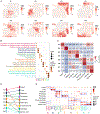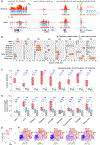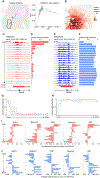Systematic analysis identifies a connection between spatial and genomic variations of chromatin states
- PMID: 39541982
- PMCID: PMC11581903
- DOI: 10.1016/j.cels.2024.10.006
Systematic analysis identifies a connection between spatial and genomic variations of chromatin states
Abstract
Chromatin states play important roles in the maintenance of cell identities, yet their spatial patterns remain poorly characterized at the organism scale. We developed a systematic approach to analyzing spatial epigenomic data and then applied it to a recently published spatial-CUT&Tag dataset that was obtained from a mouse embryo. We identified a set of spatial genes whose H3K4me3 patterns delineate tissue boundaries. These genes are enriched with tissue-specific transcription factors, and their corresponding genomic loci are marked by broad H3K4me3 domains. Integrative analysis with H3K27me3 profiles showed coordinated spatial transitions across tissue boundaries, which is marked by the continuous shortening of H3K4me3 domains and expansion of H3K27me3 domains. Motif-based analysis identified transcription factors whose activities change significantly during such transitions. Taken together, our systematic analyses reveal a strong connection between the genomic and spatial variations of chromatin states. A record of this paper's transparent peer review process is included in the supplemental information.
Keywords: CUT&Tag; chromatin state; computational biology; development; epigenomics; spatial biology.
Copyright © 2024 Elsevier Inc. All rights reserved.
Conflict of interest statement
Declaration of interests R.F. is a scientific founder and advisor of IsoPlexis, Singleron Biotechnologies, and AtlasXomics.
Figures




References
-
- Jenuwein T, and Allis CD (2001). Translating the histone code. Science 293, 1074–1080. - PubMed
-
- Kouzarides T (2007). Chromatin modifications and their function. Cell 128, 693–705. - PubMed
-
- Ren B, Robert F, Wyrick JJ, Aparicio O, Jennings EG, Simon I, Zeitlinger J, Schreiber J, Hannett N, Kanin E, et al. (2000). Genome-wide location and function of DNA binding proteins. Science 290, 2306–2309. - PubMed
-
- Barski A, Cuddapah S, Cui K, Roh T-Y, Schones DE, Wang Z, Wei G, Chepelev I, and Zhao K (2007). High-resolution profiling of histone methylations in the human genome. Cell 129, 823–837. - PubMed
MeSH terms
Substances
Grants and funding
LinkOut - more resources
Full Text Sources

